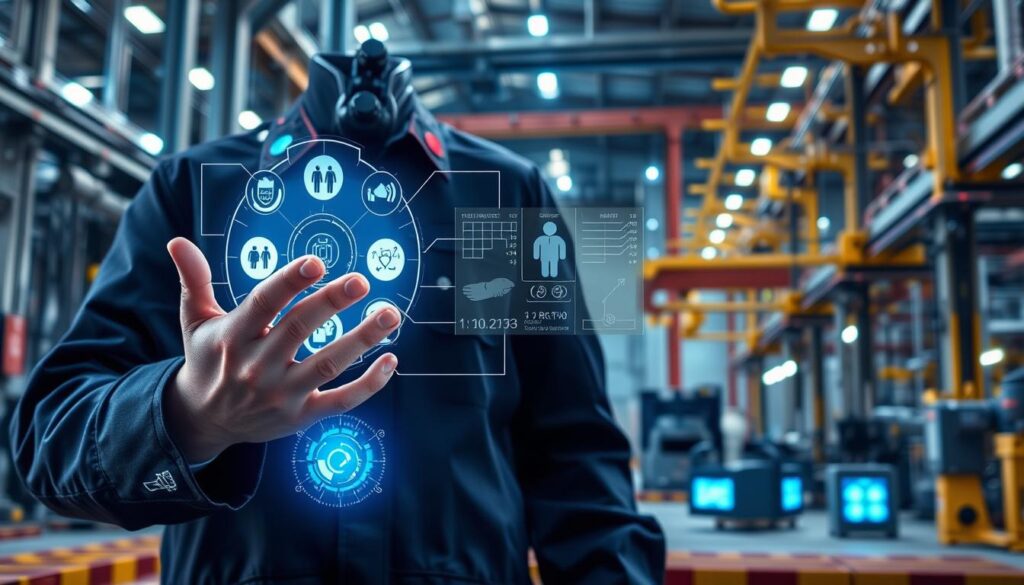Workplace safety is a big deal in the fast-changing world of industrial robotics. The International Labor Organization says nearly 1.9 million workers get sick from work, and 2.3 million die every year. New tech is changing how we keep workers safe.
Wearable sensors are a big step forward in keeping workers safe. They connect humans with robots, making work safer and smarter. They watch over workers in real time, helping stop accidents before they happen.
The growth of Industry 4.0 and the Industrial Internet of Things (IIoT) has made smart safety tech more common. Wearable sensors give us deep insights into worker health and safety. They help us manage safety better, moving from just reacting to accidents to preventing them.
As industrial robotics gets better, wearable sensors are key to safe human-robot teamwork. These new tools are changing the future of keeping workers safe at work.
Understanding Wearable Sensor Technology in Industrial Settings
Robotic systems integration has changed workplace safety with advanced wearable sensor technologies. The industrial world is seeing big changes. New devices protect workers and make work more efficient.
Wearable devices in factories are key for watching over worker safety and the environment. The global market for these technologies is growing fast. They offer advanced solutions for making robots work better in factories.
Types of Industrial Wearable Devices
- Smart safety helmets with integrated sensors
- Ergonomic wristbands tracking worker movement
- Intelligent clothing with environmental monitoring capabilities
- Biometric tracking devices for physiological indicators
Key Components of Safety Monitoring Systems
Modern wearable tech uses many advanced sensors to gather important data in real-time. These parts usually include:
- Motion tracking sensors detecting worker positioning
- Environmental condition monitors
- Vital sign measurement instruments
- Proximity detection mechanisms
Integration with Existing Safety Protocols
New wearable tech works well with old safety systems. They give instant data and predictive analytics. This creates a full safety system that keeps workers safe and work running smoothly.
More manufacturers are using these smart systems. They help lower accidents, improve worker health, and boost factory productivity.
Real-Time Health and Environmental Monitoring Capabilities

Robotics engineering services have changed workplace safety with advanced wearable sensors. These smart devices watch over worker health and the environment in factories.
The advanced sensors track important health signs. They help prevent accidents by acting fast:
- Heart rate and stress levels
- Body temperature and heat exposure
- Air quality and pollution
- Noise levels and hearing risks
Robotic programming is key in making these smart monitoring tools. Wearable devices can spot early signs of health dangers, like:
- Heat stress signs
- Fatigue in machine operators
- Potential ergonomic strain
| Sensor Type | Monitored Parameters | Safety Impact |
|---|---|---|
| Smart Wristwear | Heart Rate, Skin Temperature | Prevent Heat-Related Illnesses |
| Smart Helmets | Brain Wave Activity, Head Movement | Detect Operator Fatigue |
| Environmental Sensors | Air Quality, Noise Levels | Identify Workplace Hazards |
Industrial safety has entered a new era of prevention through real-time monitoring and intelligent sensor technologies.
Industrial Robotics Development and Wearable Sensor Integration
Advanced robotics solutions are changing workplace safety with new wearable sensor tech. These smart systems make work environments smarter and more responsive.
Today’s industrial places need top-notch safety to protect workers and keep work flowing. Wearable sensors are key, giving real-time data and predictive insights.
Collaborative Robot Safety Features
Collaborative robots, or cobots, now have advanced sensors for better safety. They have:
- Dynamic collision detection systems
- Precise movement tracking
- Instant speed and force regulation
- Automated shutdown mechanisms
Human-Robot Interaction Protocols
New industrial automation solutions support smart interaction rules for safety. These rules use wearable sensors to:
- Detect human proximity
- Adjust robotic movements automatically
- Create adaptive safety zones
- Prevent workplace accidents
Safety Zone Monitoring Systems
Wearable sensors create dynamic safety zones, changing old safety rules. Intelligent monitoring systems track worker locations and adjust robots in real-time. This cuts down on workplace dangers.
Data Analytics and Predictive Safety Measures

Robotic design and development have changed industrial safety a lot. Now, we use advanced data analytics and predictive maintenance. Wearable sensors collect complex data, changing how we manage safety and equipment.
At the heart of predictive safety are smart machine learning algorithms. They analyze sensor data in real-time. These systems can spot early signs of equipment failure or workplace risks.
- Identify early warning signs of mechanical stress
- Predict possible equipment malfunctions
- Optimize maintenance scheduling
- Reduce unexpected operational disruptions
Robotic automation services use these tools to build strong safety plans. They process lots of sensor data to help companies manage risks better. This makes workplaces safer.
| Data Analysis Metric | Safety Impact | Predictive Capability |
|---|---|---|
| Machine Vibration | Equipment Stress Detection | High Precision |
| Temperature Variations | Mechanical Wear Tracking | Medium Precision |
| Electrical Current Fluctuations | Potential Failure Prediction | Very High Precision |
Advanced predictive analytics turn raw sensor data into useful safety insights. This helps companies move from reacting to preventing risks.
Implementation Challenges and Solutions
Adding wearable sensors to work places is tough. It needs smart planning and new ideas. Robots and automation are making work safer. But, they only work well if we think about a few important things.
Technical Infrastructure Requirements
For wearable sensors to work, we need a strong tech base. Important things include:
- Fast wireless networks
- Safe cloud storage
- Systems that can handle lots of data
- Things that work with current factory systems
Worker Privacy Considerations
We must watch both safety and privacy closely. Companies should make clear rules about:
- What data to collect
- Who can see it
- How to talk about it
- Getting worker okay
Cost-Benefit Analysis
| Investment Category | Estimated Cost | Potential Savings |
|---|---|---|
| Initial Technology Implementation | $75,000 – $150,000 | Less workplace accidents |
| Annual Maintenance | $25,000 – $50,000 | Lower insurance costs |
| Training and Integration | $30,000 – $60,000 | Work better, faster |
By tackling these challenges smartly, companies can use tech to make work safer and more efficient.
Conclusion
The world of industrial safety is changing fast with robotic systems integration. Wearable sensors are key, linking human workers with advanced factories. They give deep insights into the workplace, helping to keep people safe and work more efficiently.
Robot solutions in manufacturing are now vital for safety. These sensors track biometric and environmental data in real-time. This helps prevent accidents and makes workplaces safer and more efficient.
Wearable sensors are getting better, promising even safer workplaces. Future research will aim to improve sensor accuracy and make technology simpler. It’s important for tech developers, safety experts, and leaders to work together on these advancements.
The future of safety in factories is about smart, adaptable tech. Wearable sensors are leading this change. They show a future where workplaces are safer, smarter, and better for people.

